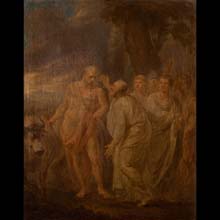
material: oil on canvas
dimensions: 61,6 x 49 cm
description: The failure of the Kościuszko Uprising meant the end of the independent Polish state. King Stanisław August Poniatowski was aware of the imminent end of his reign. On August 30, 1795, he ordered Marcello Bacciarelli to paint a picture having considerable propaganda value. The work was to illustrate the moment of nominating Cincinnatus, a Roman patrician who worked hard on his small farm, dictator and entrusting him with the task of defeating the rivalling tribes and saving Rome in the year 458 BC. After a successful military expedition, Cincinnatus returned to his humble life. Poles could regard Cincinnatus as a model example of the enlightened nobleman, capable not only of fulfilling everyday obligations at the time of peace, but also of the courageous defence of the threatened fatherland. This moralizing significance of the painting turned out to be the last message which the Polish monarch, standing on the verge of the liquidation of his state, directed to his subjects. He counted on the propaganda value of this work of art and the possibility of interpreting it in the context of the current political situation – the nation should remain dignified in the approaching difficult period of Partitions. The painting was seen as the allegorical apology for Tadeusz Kościuszko, appointed dictator by the Polish people. Barbara Ciciora
exposition: The Gallery of 19th Century Polish Art in Sukiennice,
The Cloth Hall, 1, Main Market Square
key: Enlightenment >>>
dimensions: 61,6 x 49 cm
description: The failure of the Kościuszko Uprising meant the end of the independent Polish state. King Stanisław August Poniatowski was aware of the imminent end of his reign. On August 30, 1795, he ordered Marcello Bacciarelli to paint a picture having considerable propaganda value. The work was to illustrate the moment of nominating Cincinnatus, a Roman patrician who worked hard on his small farm, dictator and entrusting him with the task of defeating the rivalling tribes and saving Rome in the year 458 BC. After a successful military expedition, Cincinnatus returned to his humble life. Poles could regard Cincinnatus as a model example of the enlightened nobleman, capable not only of fulfilling everyday obligations at the time of peace, but also of the courageous defence of the threatened fatherland. This moralizing significance of the painting turned out to be the last message which the Polish monarch, standing on the verge of the liquidation of his state, directed to his subjects. He counted on the propaganda value of this work of art and the possibility of interpreting it in the context of the current political situation – the nation should remain dignified in the approaching difficult period of Partitions. The painting was seen as the allegorical apology for Tadeusz Kościuszko, appointed dictator by the Polish people. Barbara Ciciora
exposition: The Gallery of 19th Century Polish Art in Sukiennice,
The Cloth Hall, 1, Main Market Square
key: Enlightenment >>>












